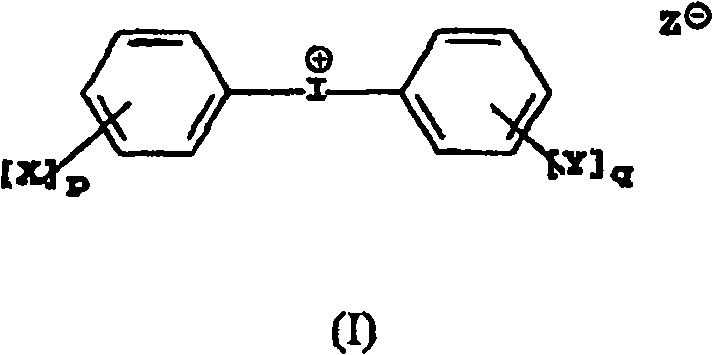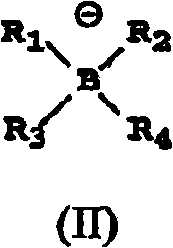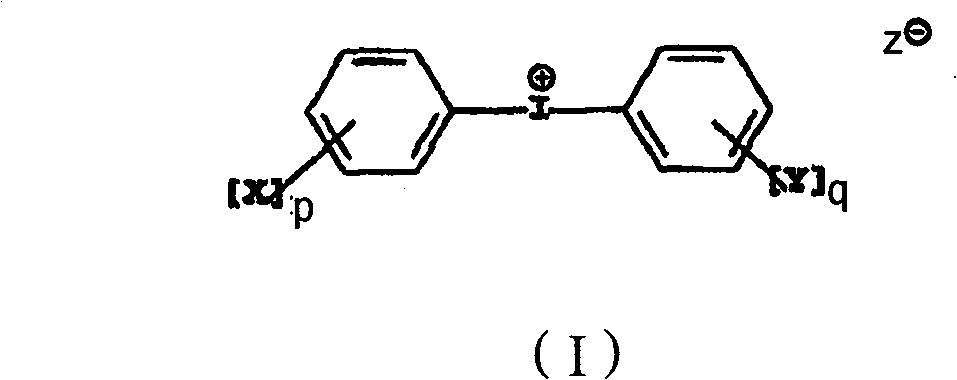Method of imaging and developing negative-working elements
An imaging and component technology, used in photography, printing technology, photosensitive material processing, etc.
- Summary
- Abstract
- Description
- Claims
- Application Information
AI Technical Summary
Problems solved by technology
Method used
Image
Examples
Embodiment 1
[0182] By adding polymer A (1.2g), oligomer A (0.83g), IR dye (0.094g), 1035 (0.50g, 5% concentration in MEK), SR-399 (1.28g), Pigment 951 (0.34g), PEGDA (0.28g), Phosmer PE (0.038g), 307 (0.32 g), and Initiator A (0.22 g) were dissolved in PGME (29.9 g) and MEK (15.0 g) to make an imageable layer formulation. Electrochemically grained and sulfuric acid anodized aluminum substrates post-treated with polyvinylphosphoric acid were coated with this formulation at a dry coating weight of approximately 1.3 g / m 2 .
[0183] Place the resulting imageable element in A Trendsetter 3244x imagesetter (Creo, Burnaby, British Columbia, Canada, a subsidiary of Eastman Kodak Company) was used and exposed with an 830 nm IR laser at 4.5 W power and varying drum speed (250-60 RPM). The imaged elements were then developed in a pan at 25°C with a 955 Developer. The minimum energy to obtain a stable solid density image and a clear background is about 120mJ / cm 2. After the resulting print...
Embodiment 2
[0185] By adding polymer B (1.2g), oligomer A (0.83g), IR dye (0.094g), 1035 (0.50g, 5% concentration in MEK), SR-399 (1.28g), Pigment 951 (0.34g), PEGDA (0.28g), Phosmer PE (0.038g), 307 (0.32 g), and Initiator A (0.22 g) were dissolved in PGME (29.9 g) and MEK (15.0 g) to make an imageable layer formulation. Electrochemically grained and sulfuric acid anodized aluminum substrates post-treated with polyvinylphosphoric acid were coated with this formulation and had a dry coating weight of approximately 1.3 g when properly dried on a rotating drum at 77°C for approximately 2 minutes / m 2
[0186] The resulting imageable elements were then imaged and processed as described in Example 1. The minimum ability to obtain a stable solid density image and a clear background is about 130mJ / cm 2 . After the resulting printing plate was kept at a constant temperature of 48°C or 38°C / 80% humidity for 5 days, it showed similar digit speed and clear background.
Embodiment 3
[0188] An imageable layer formulation was prepared as described in Example 1 and coated onto an electrochemically grained and sulfuric acid anodized aluminum substrate post-treated with polyvinylphosphoric acid, when suitably placed on a rotating drum at 77°C. After drying for about 2 minutes, the dry coating weight is about 1.3g / m 2 .
[0189] A topcoat formulation containing Airvol 203 polyvinyl alcohol (67.9 g of a 9.7% aqueous solution), polyvinylimidazole (5.8 g of a 20% aqueous solution), 2-propanol (20.7 g) and Water (405.6g). After coating the topcoat formulation in a similar manner to the imageable layer formulation, the imageable element was dried on a rotating drum at 77°C for about 2 minutes to provide about 0.35 g / m 2 dry top coat.
[0190] The resulting imageable elements were imaged and processed as described in Example 1 (except that the imaging power was 2.5W). The minimum energy required to obtain a stable solid density image and a clear background is app...
PUM
 Login to View More
Login to View More Abstract
Description
Claims
Application Information
 Login to View More
Login to View More - R&D
- Intellectual Property
- Life Sciences
- Materials
- Tech Scout
- Unparalleled Data Quality
- Higher Quality Content
- 60% Fewer Hallucinations
Browse by: Latest US Patents, China's latest patents, Technical Efficacy Thesaurus, Application Domain, Technology Topic, Popular Technical Reports.
© 2025 PatSnap. All rights reserved.Legal|Privacy policy|Modern Slavery Act Transparency Statement|Sitemap|About US| Contact US: help@patsnap.com



